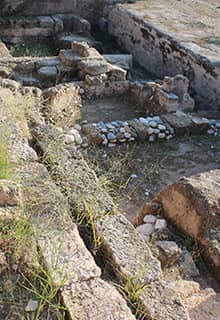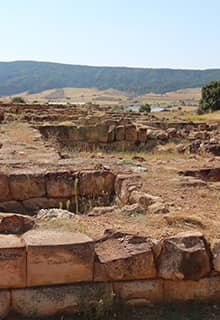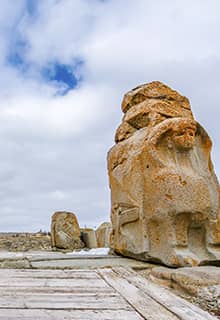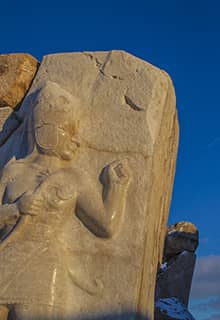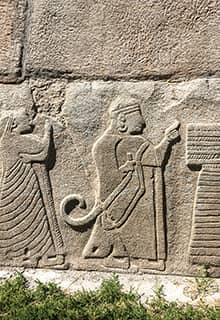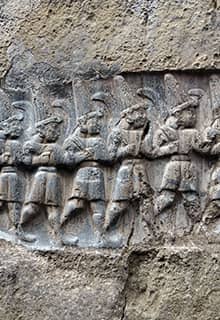

historical sites Black Sea
Türkiye
Pompeiopolis, Kastamonu
Pompeiopolis was an ancient Paphlagonia, identified in the early 19th century with the ruins of Zımbıllı Tepe, located near Taşköprü, Kastamonu. The city is situated in the valley of the Gök River. The borders of the city reached the Küre mountains to the north, Ilgaz mountains to the south, Kızılırmak, ancient Halys river to the east and Pınarbaşı valley to the west. Pompeiopolis was one of the seven cities founded by the Roman general Pompey the Great in 64 BCE, when he conquered the Pontic Kingdom in Northern Anatolia. During its peak in the 2nd Century CE, the city was the capital of the Roman Province Paphlagonia as some inscriptions bear the title "Metropolis of Paphlagonia". Being a bishopric since the early 4th century at latest, Pompeiopolis always ranked immediately after Gangra, and above the other bishoprics. Recent excavations revealed the colonnaded street, an ancient road, theater, and tombs.
- Laodicea Pontica, Samsun
- Zaliches, Samsun
- Comana Pontica, Tokat
- Ibora, Tokat
- Niksar, Tokat
Alacahöyük, Çorum
Alacahöyük is located 50 km south west of Çorum, within the boundaries of modern town Alaca. The excavations begun at the beginning of this century and are still on going. It is perhaps the most important city pre-dating the Hittites, a city of the Hatti People, natives of central Anatolia, forming main culture of the Hittites. Alacahöyük’s striking finds were unearthed from the tombs, richness of these artifcats led the scholars call these royal tombs. The finds reflect, perhaps the highest Bronze Age civilization and they are on display at Ankara Anatolian Civilizations Museum.
The city also flourished during the Hittite period; within the 2nd millennium it was an important Hittite city. The orthostat walls that welcome the visitors, are of high quality, and the main entrance is guarded by two sphinxes, and a royal ceremony relief are carved on the orthostat walls. The originals of these orthostat walls are also in Ankara; however, the replicas are excellent that it is difficult to identify them as replicas. The city is a mound, as in Hattusa, there is also a tunnel, and underground passage is Alacahöyük.
- Euchaita, Çorum
Hattusa (Capital of Hittite Empire), Çorum
Yazılıkaya, Çorum
Hattusa, or modern day Boğazkale is 85 km from Çorum, on a fertile valley in central Anatolia. It was the capital of the Hittites during the second millennium BCE. The site of the ancient city with the ruins of its temples and palaces, monumental sculptures and the enormous fortification walls with ceremonial gates and tunnels attest to the fact that this was once the home of a great imperial people. Much has been learned about the religion of these people by studying the line of gods and goddesses carved on the walls of the open-air rock sanctuary at Yazılıkaya. The relief of the Hittite pantheon constitutes one of the best exhibitions of Hittite monumental relief carvings in situ. The excavations showed that the area was inhabited as early as the 5th millennium, and the thousands of Hittite tablets changed the known ancient history. When the Hittite texts were first deciphered, scientists realized that these belong to an important empire of the 2nd millennium that was not known before. An empire that could compete with Egypt and Assyro Babylonian kingdoms. The Hittites dominated the 2nd millennium, went as far as Kadesh, and confront the Egyptians here. As a result, the first written peace treaty of the world appeared between the Hittites and the Egyptians. It was also interesting to see the Hittite version of almost all the Greek Gods, for instance, Teshup became Zeus, Hepatu became Hera. The Hittite texts also enabled us to re confirm the Egyptian texts. The city seems to flourish especially during the 14th and 13th centuries BCE, and most of the monumental buildings we see today are from this period. Like Troia, and almost all Bronze Age Settlements of Anatolia, Hattusa also was abandoned and never recovered again after 12thy century BCE.
Today the visitor can visit Hattusa in two parts, Yazılıkaya, the open air rock sanctuary of the Hittites, and the city itself. Yazılıkaya rock sanctuary is unique, the biggest open air sanctuary of this period. As you enter the sanctuary, you will see the foundations of a building complex, that was the offices in charge of maintaining the sanctuary. As you continue suddenly reliefs on rock surfaces will appear. On the left you will see all the male gods, and on the right, you will see the female goddess’, all approaching to the main scene, where Teshup and his wife Hepatu, standing on mountain lions are meeting. Immediately on the far right side, you will see the Great King Tudhaliya’s relief, who was in charge of the final construction if this sanctuary. In the 2nd room behind, there are the reliefs of major 12 Hittite Gods, Sword God Nergal, and our King Tudhaliya being embraced by god Sharruma. Perhaps this room was related to the funeral of Tudhaliya.
The city contains the great temple, Lions gate, Yerkapı – or Sphinx gate-, Kings gate, The Burial chambers and the Phrygian Castle, The Great palace, and the well reconstructed fortifications. A visit to both Boğazkale and Çorum Museums will add a lot to your visit.
- Hüseyindede Tepe, Çorum
Sapinuwa, Çorum
Sapinuwa is located 70 km south of Çorum, close to modern town of Ortaköy. The Hittite City is a flat and extensive settlement situated on the plateau stretching as terraces on the northern slopes of the Valley of Özderesi. The strategic location of Şapinuwa was especially important. The mountains surrounding the city and the plateau ascending in terraces on the Amasya plain, the fortification facilities starting as far as 5 km enable the city to be easily defendable. The discovery of the ruins of the Hittite city of Şapinuwa was a huge surprise, although archaeological work has been conducted on this site since 1990, many of the issues associated with the importance and the role Şapinuwa played during the period of Hittite domination remained a mystery. The researchers conducting excavations in Şapinuwa claim that it was the second capital of the Hittites or the royal residence of the rulers. The most valuable discovery made so far in Şapinuwa is a collection of over three thousand pieces of clay tablets from the second millennium BCE. The visitor to Şapinuwa today will enjoy on an early Hittite city, foundations of temples, houses, and palaces and several in situ clay pottery. Most of the finds are on display in Çorum Museum.

